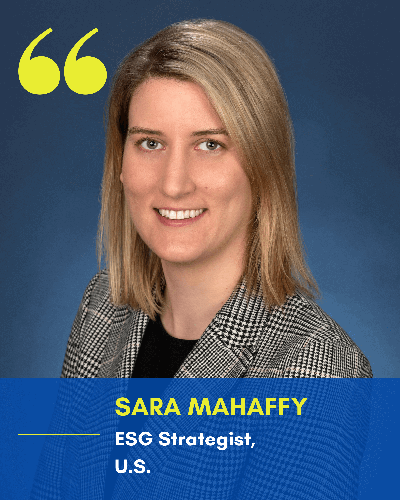
Investitutional Investor Ranking
- Sara Mahaffy ranked 3rd in the first ESG Research ranking
- Jonathan Atkin maintained his no.1 ranking in Communications infrastructure
- Matt Hedberg maintained his no.2 ranking in Small/Mid Software
- Mike Dahl maintained his no.3 ranking in Homebuilding and Building Products
RBC’s U.S. Capital Markets Research team continues to perform strong within the marketplace, and following the recent recognition in Institutional Investor’s rankings, we caught up with some of our analysts to discuss how Covid-19 affected their industry and what they expect to see in the future.

What is a significant trend you see emerging within your sector over the next 3-5 years?
One trend we are seeing right now is greater regulatory focus around ESG disclosures – both for asset managers and corporates. The EU has led the way on this front, but a number of countries are working on new initiatives to increase transparency and prevent greenwashing. In the near term, there will be an adjustment period, but longer term I think these policies will help to further steer capital towards sustainable investments.
What impact has the pandemic had on your sector and how have you adapted to help clients in this environment almost two years in?
The pandemic really accelerated the push towards sustaina;?//ble investing – last year we saw record inflows into ESG funds and record ESG fund launches. One driver of this was the performance of ESG factors during the pandemic. In my work, I found that companies with stronger ESG assessments were more resilient during the market downturn. ESG was actually added as a new Institutional Investor category this year, which I think illustrates the growing importance of ESG to investors. We also saw different ESG issues come into focus during the pandemic, particularly around social factors, i.e. health & safety, diversity & inclusion, and access & affordability, to name a few.

What is a significant trend you see emerging within your sector over the next 3-5 years?
I am seeing a greater adoption of IT outsourcing, online content, mobile access, and broadband that should continue to fuel demand for digital infrastructure assets.
What impact has the pandemic had on your sector and how have you adapted to help clients in this environment almost two years on?
Data infrastructure was critical to economic activity during the pandemic. As a result, there was demand growth for datacenters, towers and fiber continued apace. Our franchise at RBC has leveraged its global contacts in the industry to keep clients informed of operating trends.

What is a significant trend you see emerging within your sector over the next 3-5 years?
While trends in cloud computing and SaaS were well established in a pre-COVID world, we believe COVID accelerated cloud computing trends by five years or more – something we refer to as “Faster to the Future.” The result is that we believe software is eating the world at an accelerated pace, which we believe makes software the most durable and powerful long-term investment theme across the market.
What impact has the pandemic had on your sector and how have you adapted to help clients in this environment almost two years on?
COVID accelerated trends already in motion, which illustrated the power of software in all aspects of our lives, be it at work, at home, within a school, while exercising, or on vacation. Over the past two years, we’ve tried to bring our clients differentiated and value added research in a virtual setting, which in some regards allowed us to deliver even more content than if these events were in person. In addition, we try to take more of a long-term approach to software investing, trying to identify durable trends that can point to elevated long term growth and profitability.

What is a significant trend you see emerging within your sector over the next 3-5 years?
There are a number of fascinating outcomes and unknowns impacting housing and our outlook. On a structural level, two of the major themes we see are:
- Labor and supply chain shortages. Every sector has been dealing with these lately, but even prior to the pandemic labor was a constraint for years in the homebuilding industry, and this has been exacerbated by the pandemic without an easy fix in sight given the aging of the skilled labor force. We anticipate this will lead to further accelerated adoption of offsite construction methods, using both existing and potentially more innovative technologies to shift labor out of the field and onto a manufacturing floor in order to gain production efficiencies.
- Housing and construction were woefully behind on digital prior to COVID, and the pandemic forced a shift almost overnight, accelerating years of progress into the past 18+ months on the sales, design and mortgage processes. There’s no going back now, and it’s incumbent on all companies to further adapt to meet these changes, which could produce more differentiation between winners and losers over time.
What impact has the pandemic had on your sector and how have you adapted to help clients in this environment almost two years on?
The pandemic has been a boon for housing, creating strong demand tailwinds but also extreme difficulties for the pace of production, which has led to unprecedented levels of home price appreciation and, in our view, a lot of cross currents as we look forward. Our sector is notoriously volatile, but the volatility we’ve experienced over the past 18 months is still startling.
A few things have helped us adapt to best serve clients in such a dynamic period:
- 1. First and foremost, we try to make ourselves as available as possible to our clients, whether that’s via phone, e-mail or video. Everything is moving quickly, and we’re always a responsive team, but now more than ever responsiveness is critical.
- We’re very data-based, which I believe helps to ground us. We also have an incredible partnership with RBC Elements, and our flagship Elements-driven “Big Data Behind Big Builders” report has given us another “in” with clients.
- I started covering this space in 2006, so I had a front row seat to the housing crash and subsequent recovery, which I think helped us to at least somewhat contextualize the current cycle. It also means I’m not afraid to make non-consensus calls, which I think our clients appreciate.



